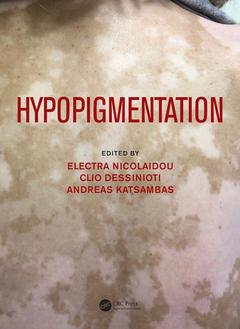Hypopigmentation
Coordonnateurs : Nicolaidou Electra, Dessinioti Clio, Katsambas Andreas

There are many disorders of a lack of pigmentation in the skin, with different causations
and effects, of which vitiligo is only the best known; this comprehensive text from international
experts will enable clinicians to diagnose the full range of these conditions and suggest
the most effective management options for their patients.
Contents: Basic concepts of melanocyte biology * Approach to hypopigmentation *
Historical review of vitiligo * Epidemiology and classification of vitiligo * Pathophysiology
of vitiligo * Segmental vitiligo * Childhood versus post-childhood vitiligo * Pharmacological
therapy of vitiligo * Surgical treatment of vitiligo * Phototherapy and lasers in the treatment
of vitiligo * Emerging treatments for vitiligo * Tuberous sclerosis complex * Oculocutaneous
albinism * Hermansky-Pudlak syndrome, Chediak-Chigasi syndrome, and Griscelli
syndrome * Piebaldism * Waardenburg syndrome * Alezzandrini syndrome, Margolis
syndrome, Cross syndrome, and other rare genetic disorders * Mosaic hypopigmentation
* Skin disorders causing post-inflammatory hypopigmentation * Infectious and parasitic
causes of hypopigmentation * Melanoma leukoderma * Halo nevi * Drug-induced hypopigmentation
* Hypopigmentation from chemical and physical agents * Guttate hypomelanosis
and progressive hypomelanosis of the trunk (progressive macular hypomelanosis)
1. Basic concepts of melanocyte biology. 2. Approach to hypopigmentation. 3. Historical review of vitiligo. 4. Epidemiology and classification of vitiligo. 5. Pathophysiology of vitiligo. 6. Segmental vitiligo. 7. Childhood versus post-childhood vitiligo. 8. Pharmacological therapy of vitiligo. 9. Surgical treatment of vitiligo. 10. Phototherapy and lasers in the treatment of vitiligo. 11. Emerging treatments for vitiligo. 12. Tuberous sclerosis complex. 13. Oculocutaneous albinism. 14. Hermansky-Pudlak syndrome, Chediak-Chigasi syndrome, and Griscelli syndrome. 15. Piebaldism. 16. Waardenburg syndrome. 17. Alezzandrini syndrome, Margolis syndrome, Cross syndrome, and other rare genetic disorders. 18. Mosaic hypopigmentation. 19. Skin disorders causing post-inflammatory hypopigmentation. 20. Infectious and parasitic causes of hypopigmentation. 21. Melanoma leukoderma. 22. Halo nevi. 23. Drug-induced hypopigmentation. 24. Hypopigmentation from chemical and physical agents. 25. Guttate hypomelanosis and progressive hypomelanosis of the trunk (progressive macular hypomelanosis).
Electra Nicolaidou, MD, PhD Associate Professor of Dermatology and Venereology, 1st Department of Dermatology and Venereology, National and Kapodistrian University of Athens Medical School, and "Andreas Sygros" Hospital for Skin and Venereal Disease, Athens, Greece
Clio Dessinioti, MD, Msc, PhD Clinical Fellow, 1st Department of Dermatology and Venereology, National and Kapodistrian University of Athens Medical School, and "Andreas Sygros" Hospital for Skin and Venereal Disease, Athens, Greece
Andreas D. Katsambas, MD, PhD Emeritus Professor of Dermatology and Venereology, National and Kapodistrian University of Athens Medical School, and Head, Dermatology Clinic, Hygeia Hospital, Athens, Greece
Date de parution : 09-2019
21x28 cm
Disponible chez l'éditeur (délai d'approvisionnement : 14 jours).
Prix indicatif 264,58 €
Ajouter au panierThèmes de Hypopigmentation :
Mots-clés :
NB UVB; Methylphenidate Transdermal System; white patches; NB UVB Therapy; discolored skin; Light Therapy; vitiligo; Phototherapy; white spots; NB UVB Phototherapy; skin discoloration; Allogeneic Hematopoietic Stem Cell Transplantation; Narrowband UVB; Nonsegmental Vitiligo; Benign Melanocytic Nevi; Halo Nevus; Stable Vitiligo; WS Type; Vitiligo Vulgaris; GS; Oculocutaneous Albinism; HPS; Chs; Hypopigmented Macules; SV; Vitiligo Treatment; TSC Patient; PD-1 Receptor; Vitiligo Lesions; MEL



